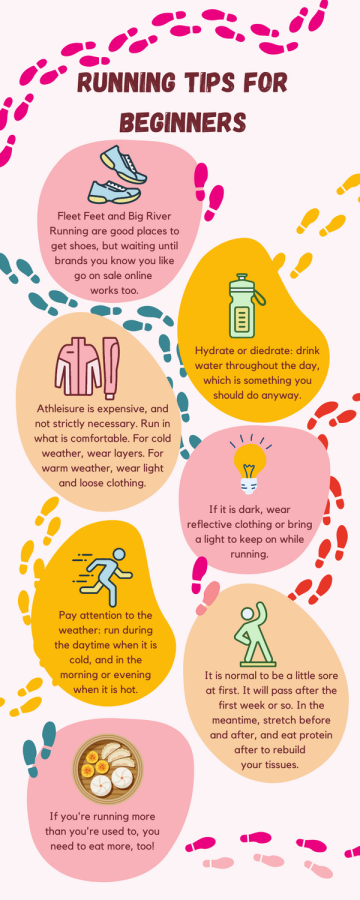New Year, New Shoes
Tips for how to set a goal and actually make it this year around
January 18, 2023
Quitter’s Day, the second Friday of January, makes its name as the international day where most people drop their resolutions for the new year. Dropped and forgotten, these goals languish on the backburner until they return the following year. One of the most common resolutions is to “be healthier.” The vaguer the term, the more difficult it is to carry through, which is why a physical goal tends to be clearer to achieve due to its observable nature.
Running is one method to achieve a healthier lifestyle, along with similar goals of lowering stress, spending more time outside, getting quality sleep, and much more. One of the most versatile and cheap activities to the casual goal setter, running can check all of the boxes. My experience is primarily distance running, so that is the focus here.
10 Reasons Why Everyone Should Run
It’s Healthy
Benefits of running include the general benefits of exercise: it strengthens the heart, increases bone density and is even good for skin. Some studies have reported that people who run tend to live longer, too.
It’s Simple
As long as you have sneakers and anywhere with ground, that is enough to begin running. Other things you don’t need to run include: a Hydro Flask, gym membership, treadmill, other people, fancy equipment, an indoor location and specific temperatures. Of course these can help, but it’s optional.
For the Brain
Running strengthens your mind scientifically in how it improves memory and can prevent Alzheimer’s, but also emotionally by building mental strength. Distance running especially builds endurance physically, but more importantly mentally. The ability to begin, knowing that there are three, five, 10 miles left requires strength, as well as knowing there is a final stretch. This mental strength carries over beyond running to other activities that require patience and endurance, such as slow walkers, high school and irritating conversations.
Most people have heard of how the brain releases endorphins in exercise that make people happy, also called the runner’s high. From a biased perspective, it is one of the best feelings in the world, since symptoms include feeling like you can do anything and everything will turn out okay.
Fresh Air
Going outside has benefits such as fresh air, sunlight and sometimes water. Running outside lets you really look at your neighborhood or city, taking the time to look at the smaller details. Even if it is something as simple as lawn decorations or car license plates, stability is not always valued as highly as it ought to be.
Bragging Rights
The feeling of accomplishment is something that cannot be experienced in any other way than by just finishing. Earning the ability to say that you’ve finished a day or a week of running, or ran a race in a certain time, is something that no one can take away from you.
Stress Relief
Whether you think about how much it hurts, have a conversation with yourself or a running partner or space out, running is a distraction that is much like sleep. A self imposed break from the world, running can relieve stress by giving a pocket of time to check out.
Quiet Time
Listening to music or a podcast while running can be entertaining, but quiet time is sometimes the most valuable time of all.
Sleep Better
Being tired means the quality of your sleep increases too. Sleep is good for you. Case closed.
Increase Productivity
Runners often report more motivation and productivity after running in the morning. Running after school can get you ready to start your homework, or if you’re the type to run, shower, eat, nap, then wake up for homework, to each their own.
Neighborhood Connections
I’ve been running in my neighborhood since I was in middle school, but technically since elementary school if you count the running club before school. The good thing about running is that if you don’t stop, you don’t have to talk to people you see on the road. Waving is a nice thing to do, and observing and really looking at people means you can build very strong parasocial relationships with the dogs and regulars.
10 Ways to Start Running
Obviously every person is different, so not all of these may work.
Make it a Routine
Routines depend on the person: for some, a routine has to be every day or else it doesn’t work, for others, three or four times a week prevents it from being overwhelming. When you aren’t running every day, it becomes easy to say you’ll do it tomorrow, so it helps to write it down or set a reminder, or tell people you are going to run so others can hold you accountable. For beginners, it may be overwhelming to start by running every day. Try to be safe by varying distances and speeds to adjust to your needs. If you haven’t run in a while, be kind to yourself, and go with what feels right. Start with two or three miles and work your way up.
Start by Walking
Running is great, but walking can reap many of the same benefits.
Progress to a Fartlek Run
Fartlek is Swedish for “speed” and “play.” You alternate between a few minutes of walking and a few minutes of running. Beginners might start with one minute of running and two minutes of walking, and repeat until you reach 15 minutes. That can gradually increase to maybe two minutes of each, then two minutes of running and one minute of walking, then three minutes of running and one minute of walking. Eventually, you can switch between easy running and faster running.
Stretch
Stretching before and after a run prevents injury, and can build a running routine.
Running Shoes Don’t Hurt
Running shoes are often expensive, and while they do not have to be, if you wait for expensive ones to go on sale you can get shoes that make you feel like you’re floating. Wearing clouds is definitely a motivator to go outside to wear them.
Track Your Progress
If you have a watch or anything else that records time and mileage, you can record that in an app, spreadsheet, or notebook. Just like how Snapchat and Duolingo taps into the brain for streaks, that is definitely a way to do it. You can also plan out what you’re doing each day or week with a mileage goal using Strava or Google Spreadsheets.
Try Different Routes
Go a different direction. Go down that cul-de-sac. Go past that gas station. Go to Creve Coeur Lake. Go to Katy Trail (don’t get run over by bikers). Of course, safety first, especially in an unfamiliar location. Bring a friend or make sure you have your cell phone on hand.
Set a Goal
For distance running in particular, a good method is to work towards weekly mileage goals, a long run at the end of the week, or a combination of both. Going weekly, increase for two weeks, then stay or even backtrack to avoid injury. Long run mileage begins at five miles for beginners, then increases every other week. Depending on your gender, age and experience, the distance you max out at ranges.
Just Say You’ll Do it for a Month
Habits take a long time to build, and without anyone to hold you accountable for reaching any goal, it is easy to let it go. Setting a time limit to try something to see if it is right for you is a self imposed checkpoint that gives you enough time to see the pros and cons, and then you can make an informed decision.
Join a Group
If going alone doesn’t provide enough motivation, join a group. Ask a friend, family member or neighbor to go with you. Choose someone at a similar ability level so you don’t compare yourself to someone at a completely different stage.
Central has winter conditioning after school every day from Monday through Thursday from 2:50-5:15 p.m., and track and field begins in the spring.


